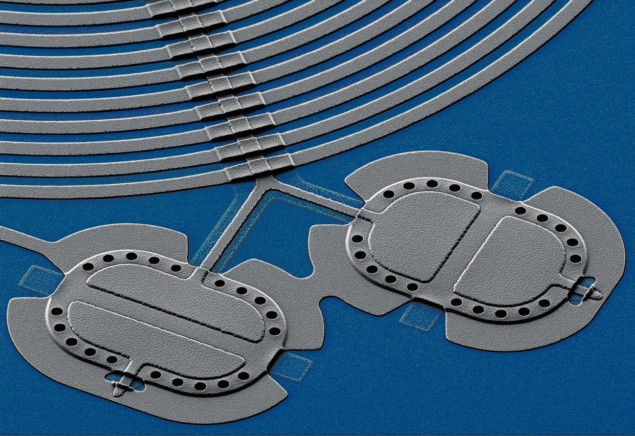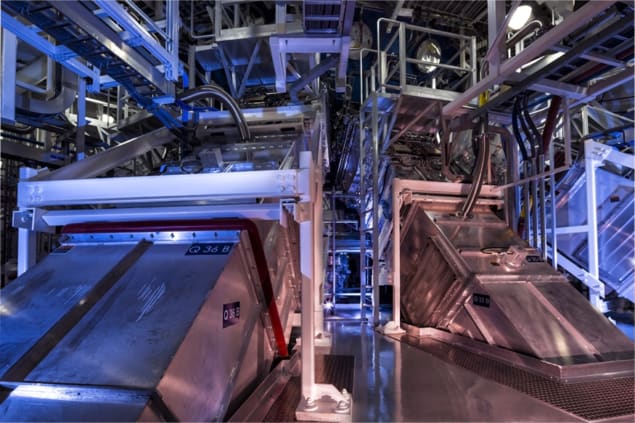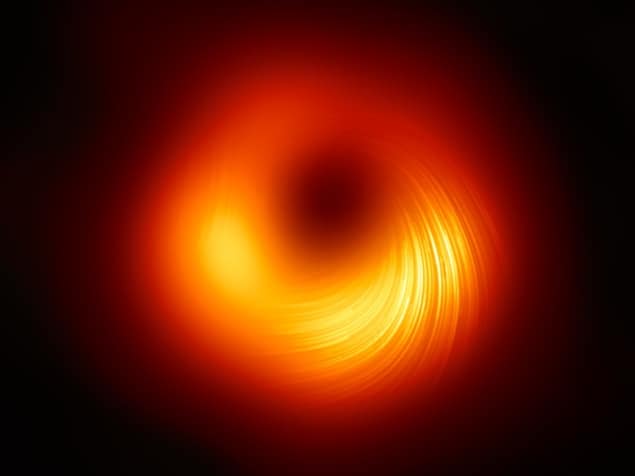Quantum entanglement of two macroscopic objects is the Physics World 2021 Breakthrough of the Year
14 Dec 2021 Hamish Johnston
The Physics World 2021 Breakthrough of the Year goes to two independent teams for entangling two macroscopic vibrating drumheads, thereby advancing our understanding of the divide between quantum and classical systems. The winners are Mika Sillanpää and colleagues at Aalto University, Finland and the University of New South Wales, Australia, together with a team led by John Teufel and Shlomi Kotler of the US National Institute of Standards and Technology (NIST).
Nine other achievements are highly commended in our Top 10 Breakthroughs of 2021.

Quantum technology has made great strides over the past two decades and physicists are now able to construct and manipulate systems that were once in the realm of thought experiments. One particularly fascinating avenue of inquiry is the fuzzy border between quantum and classical physics. In the past, a clear delineation could be made in terms of size: tiny objects such as photons and electrons inhabit the quantum world whereas large objects such as billiard balls obey classical physics.
Over the past decade, physicists have been pushing the limits of what is quantum using drum-like mechanical resonators measuring around 10 microns across. Unlike electrons or photons, these drumheads are macroscopic objects that are manufactured using standard micromachining techniques and appear as solid as billiard balls in electron microscope images (see figure). Yet despite the resonators’ tangible nature, researchers have been able to observe their quantum properties, for example, by putting a device into its quantum ground state as Teufel and colleagues did in 2017.
This year, teams led by Teufel and Kotler and independently by Sillanpää went a step further, becoming the first to quantum-mechanically entangle two such drumheads. The two groups generated their entanglement in different ways. While the Aalto/Canberra team used a specially chosen resonant frequency to eliminate noise in the system that could have disturbed the entangled state, the NIST group’s entanglement resembled a two-qubit gate in which the form of the entangled state depends on the initial states of the drumheads.
Both teams overcame significant experimental challenges, and their considerable efforts could open the door for entangled resonators to be used as quantum sensors or as nodes in quantum networks. As a result, this work deserves its place as the first quantum-related Breakthrough of the Year since 2015.
Selection criteria
The Breakthrough of the Year and the nine runners-up are selected by five Physics World editors from a list of nearly 600 research updates published on the website this year. In addition to having been reported in Physics World in 2021, our selections must meet the following criteria:
Significant advance in knowledge or understanding
Importance of work for scientific progress and/or development of real-world applications
Of general interest to Physics World readers
Here are the nine runners-up that make up the rest of the Physics World Top 10 Breakthroughs for 2021. You can listen to our editors talk about the Top Ten in this episode of the Physics World Weekly podcast.
Restoring speech in a paralysed man Think before you speak: Clinical trial testing session with researcher David Moses. During the session, a neuroprosthesis recorded the participant’s cortical activity while he attempted to produce words and sentences. (Courtesy: Todd Dubnicoff, UCSF)
Think before you speak: Clinical trial testing session with researcher David Moses. During the session, a neuroprosthesis recorded the participant’s cortical activity while he attempted to produce words and sentences. (Courtesy: Todd Dubnicoff, UCSF)
 Think before you speak: Clinical trial testing session with researcher David Moses. During the session, a neuroprosthesis recorded the participant’s cortical activity while he attempted to produce words and sentences. (Courtesy: Todd Dubnicoff, UCSF)
Think before you speak: Clinical trial testing session with researcher David Moses. During the session, a neuroprosthesis recorded the participant’s cortical activity while he attempted to produce words and sentences. (Courtesy: Todd Dubnicoff, UCSF)To Edward Chang, David Moses, Sean Metzger, Jessie Liu and colleagues at the University of California San Francisco for developing a speech neuroprosthesis that enabled a man with severe paralysis to communicate in sentences, by translating his brain signals directly into words on a screen. To achieve this, the team used a high-density electrode array implanted on the surface of the participant’s brain to record electrical activity in multiple cortical regions involved in speech formulation. Based on a 50-word vocabulary that the system could identify from patterns in recorded cortical activity, he was able to produce hundreds of short sentences. The technique showed a promising median decoding rate of 15.2 words per minute – around three times faster than the computer-based typing interface that he normally used for communication.
To Sebastian Klembt of the University of Würzburg, Germany, Mordechai Segev of the Technion-Israel Institute of Technology, and colleagues for creating an array of 30 vertical cavity surface emitting lasers (VCSELs) that behave as a single coherent light source, paving the way for large-scale, high-power applications. The team drew on principles of topological photonics to ensure that light from each laser in the array flows through all the others, forcing them to emit at the same frequency. The new design overcomes the power limitations of a previous device built by Segev and collaborators in 2018, and can in principle be scaled up to incorporate hundreds of individual lasers.
To Tai Hyun Yoon and Minhaeng Cho of the Institute for Basic Science, South Korea; Xiaofeng Qian of the Stevens Institute of Technology, US; and Girish Agarwal of Texas A&M University, US for experimental and theoretical work quantifying the “wave-ness” and “particle-ness” of a photon and demonstrating that both properties are related to the purity of the photon source. In their experiment, Yoon and Cho tightly controlled the quantum state of pairs of photons – a “signal” and an “idler” – emitted by two crystals of lithium niobate. By independently altering the chances that each crystal would emit photons, they showed that this so-called source purity is related to the visibility of interference fringes (a wave-like property) and path distinguishability (a particle-like property) by a simple mathematical expression first articulated by Qian and Agarwal in 2020. The result has applications in quantum information and puts a new twist on interpretations of complementarity – the idea, originating from the 20th-century quantum pioneer Niels Bohr, that quantum objects sometimes behave like waves, and sometimes like particles.
Milestone for laser fusion Burning question: Scientists at the $3.5bn National Ignition Facility are nearer to achieving ignition – the point at which fusion reactions generate at least as much energy delivered by the laser system (Courtesy: NIF)
Burning question: Scientists at the $3.5bn National Ignition Facility are nearer to achieving ignition – the point at which fusion reactions generate at least as much energy delivered by the laser system (Courtesy: NIF)
 Burning question: Scientists at the $3.5bn National Ignition Facility are nearer to achieving ignition – the point at which fusion reactions generate at least as much energy delivered by the laser system (Courtesy: NIF)
Burning question: Scientists at the $3.5bn National Ignition Facility are nearer to achieving ignition – the point at which fusion reactions generate at least as much energy delivered by the laser system (Courtesy: NIF)To Omar Hurricane, Annie Kritcher, Alex Zylstra, Debbie Callahan and colleagues at the National Ignition Facility (NIF) in California, US, for taking a step closer to their ultimate goal of realizing “ignition”. Since NIF was turned on over a decade ago, its long-term goal has been to show it can achieve ignition – the point at which fusion reactions generate at least as much energy as its lasers put in. This involves self-sustaining reactions, in which the alpha particles that are also emitted during fusion emit heat to initiate further fusion. NIF, which is operated by the Lawrence Livermore National Laboratory, trains 192 pulsed laser beams on to the inner surface of a centimetre-long hollow metal cylinder known as a hohlraum. Inside is a fuel capsule, which is a roughly 2 mm-diameter hollow sphere containing a thin deuterium-tritium layer. Experiments between 2009 and 2012 fell well short of reaching ignition and so researchers went back to the drawing board to make improvements. That paid off spectacularly on 8 August when researchers achieved an energy yield of more than 1.3 MJ – about 70% of the energy that the laser pulse delivered to the sample. Although still short of break-even, the figure far exceeded previous markers of around 0.1 MJ and some experts have described the result as the most significant advance in inertial fusion since it began in 1972.
To researchers from the Antihydrogen Laser Physics Apparatus (ALPHA) and the Baryon Antibaryon Symmetry Experiment (BASE) collaborations at CERN, for two separate studies presenting new ways to cool particles and antiparticles. The techniques could pave the way for precision studies examining the matter–antimatter asymmetry in the universe. The ALPHA collaboration demonstrated laser-cooling of antihydrogen atoms for the first time. To achieve this, the physicists developed a new type of laser, which produces 121.6 nm laser pulses, to cool the antiatoms. They then measured a key electronic transition in antihydrogen with unprecedented precision, a breakthrough that could lead to improved tests of other key properties of antimatter. The BASE researchers, meanwhile, showed how to extract heat from a single proton via a superconducting circuit connected to a cloud of laser-cooled ions several centimetres away – a technique, they say, that could easily be applied to antiprotons.
Observing a black hole’s magnetic field Magnetic swirl: A view of the M87* supermassive black hole in polarized light. The lines mark the orientation of the polarization, which is related to the magnetic field around the shadow of the black hole. (Courtesy: EHT Collaboration)
Magnetic swirl: A view of the M87* supermassive black hole in polarized light. The lines mark the orientation of the polarization, which is related to the magnetic field around the shadow of the black hole. (Courtesy: EHT Collaboration)
 Magnetic swirl: A view of the M87* supermassive black hole in polarized light. The lines mark the orientation of the polarization, which is related to the magnetic field around the shadow of the black hole. (Courtesy: EHT Collaboration)
Magnetic swirl: A view of the M87* supermassive black hole in polarized light. The lines mark the orientation of the polarization, which is related to the magnetic field around the shadow of the black hole. (Courtesy: EHT Collaboration)To the Event Horizon Telescope Collaboration (EHT) for creating the first image showing the polarization of light in the region surrounding a supermassive black hole. The polarization reveals the presence of strong magnetic fields in an area where matter is accelerating into M87*, a black hole more than six billion times the mass of the Sun. Further study of this polarization could provide important insights into how some black holes create huge jets that eject matter and radiation into surrounding space. In 2019 the EHT made history by capturing the first image of the shadow of a black hole, and the collaboration was awarded the Physics World 2019 Breakthrough of the Year for that work.
To Jörg Evers and colleagues at the Max Planck Institute for Nuclear Physics in Heidelberg and the Deutsches Elektronen-Synchrotron – both in Germany – and the European Synchrotron Radiation Facility in France, for being the first to achieve the coherent quantum control of nuclear excitations. The team used X-ray light from a synchrotron that was delivered to the nuclei in two ultrashort pulses. By adjusting the phase of the pulses, the team could toggle iron nuclei between coherent enhanced excitation and coherent enhanced emission. As well as providing a better understanding of quantum matter, the work could hasten the development of new technologies such as ultra-precise nuclear clocks and batteries that can store huge amounts of energy.
To Christian Sanner and colleagues at JILA in the US; Amita Deb and Niels Kjærgaard at the University of Otago; and Wolfgang Ketterle and colleagues at the Massachusetts Institute of Technology in the US, for independently observing Pauli blocking in ultracold gases of fermionic atoms. Pauli blocking occurs in such gases because the constituent atoms fill nearly all available low-energy quantum states, which prevents atoms from making small transitions to neighbouring states. This affects how light scatters from atoms in the gas, and all three teams observed that Pauli blocking increased the transparency of their gases as they were cooled. The effect could someday be used to improve technologies based on ultracold atoms such as optical clocks and quantum repeaters.
Confirming the muon’s theory-defying magnetism New home: The Muon g-2 ring sits in its detector hall at Fermilab, where it studies precession of muons. (Courtesy: Reidar Hahn/Fermilab)
New home: The Muon g-2 ring sits in its detector hall at Fermilab, where it studies precession of muons. (Courtesy: Reidar Hahn/Fermilab)
 New home: The Muon g-2 ring sits in its detector hall at Fermilab, where it studies precession of muons. (Courtesy: Reidar Hahn/Fermilab)
New home: The Muon g-2 ring sits in its detector hall at Fermilab, where it studies precession of muons. (Courtesy: Reidar Hahn/Fermilab)To the Muon g–2 collaboration for providing further evidence that the measured value of the muon’s magnetic moment disagrees with theoretical predictions. The international team circulated a beam of magnetically polarized muons in a storage ring at Fermilab in the US. The magnetic moments of the muons were rotated by a magnetic field and the rotation rate gave the size of the muon’s magnetic moment. The discrepancy between theory and experiment was first revealed two decades ago at Brookhaven National Laboratory. Now the combined Fermilab/Brookhaven results put the difference between experiment and theory at 4.2σ, which is less than the 5σ required for a discovery. If the discrepancy stands the test of future experiments, it could point to new physics beyond the Standard Model.
Additional reporting by Michael Banks, Tami Freeman and Margaret Harris. There is more about this year’s shortlist in the Physics World Weekly podcast where we have a lively discussion about all of the entries.
from physicsworld.com 17/12/2021
Δεν υπάρχουν σχόλια:
Δημοσίευση σχολίου